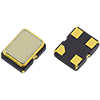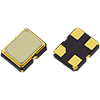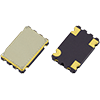Frequency Control in Medical Devices: Ensuring Accuracy and Reliability
15 Jan 2024
KATIEJENKIN@GOLLEDGE.COM
In the world of healthcare, precision is paramount. From life-saving surgeries to the continuous monitoring of patients, medical device reliability plays a critical role in ensuring accurate diagnoses and effective treatment. At the heart of these devices lies a silent hero - frequency control.
In this blog post, we'll talk about the essential role of frequency control in medical device design and explore the challenges, solutions, and future possibilities that surround it.
The Role of Frequency Control in Medical Device Design
Frequency control plays a critical role in the design and operation of medical devices, ensuring precision, reliability, and accuracy in various healthcare applications. Here's an overview of how frequency control components contribute to the performance and functionality of medical devices:
- Synchronisation and timing accuracy: Frequency control components such as crystal oscillators and real-time clocks provide precise timing signals essential for synchronising data acquisition, processing, and transmission within medical devices. Accurate timing is crucial for coordinating the operation of sensors, actuators, and communication interfaces, ensuring seamless functionality and reliable performance.
- Data acquisition and processing: In medical devices that rely on data acquisition and processing, such as patient monitors, diagnostic equipment, and imaging systems, frequency control components enable high-speed and accurate sampling, conversion, and analysis of biological signals and imaging data. Stable clock signals from oscillators and filters ensure consistent and reliable data processing, enhancing the accuracy and efficacy of medical diagnostics and treatments.
- Wireless communication and connectivity: With the increasing integration of wireless communication technologies in medical devices, frequency control products are important in ensuring robust and interference-free wireless connectivity. Surface acoustic wave (SAW) filters and duplexers help manage radio frequency (RF) signals, minimise signal interference, and optimise signal transmission and reception. It enhances the reliability and performance of wireless medical devices such as implantable devices, remote monitoring systems, and wearable health trackers.
- Power management and battery life: Efficient power management is essential for prolonging battery life and optimising energy consumption in portable and implantable medical devices. Low-power frequency control solutions, such as temperature-compensated crystal oscillators (TCXOs) and voltage-controlled crystal oscillators (VCXOs), help minimise power consumption without compromising timing accuracy or signal stability. It extends the operational lifespan of battery-powered medical devices and reduces the need for frequent battery replacements or recharging.
- Regulatory compliance and quality assurance: Frequency control components used in medical devices must meet stringent safety requirements and quality standards to ensure patient safety and device reliability. Manufacturers rely on reputable suppliers with proven track records to deliver components that meet the demanding performance, reliability, and safety standards mandated by regulatory authorities.
Challenges and Considerations in Frequency Control for Medical Devices
Precision and synchronisation are non-negotiable in the medical device industry. They rely on accurate timekeeping and synchronized operations to deliver reliable results. However, achieving this level of precision in the medical field can be a bit challenging. Factors like temperature variations, electromagnetic interference, and power fluctuations can impact the stability of oscillators and crystals, making accurate frequency control a complex task. This section will outline the challenges involved in maintaining precise frequencies and how they are tackled in medical device design.
Temperature Variations: The Temperature Tightrope
Temperature fluctuations, both environmental and physiological, can pose a significant challenge to maintaining precise frequency control. For instance, in the operating room, medical equipment may be exposed to a wide range of temperatures, from the sterility of a cold environment to the heat generated by surgical procedures. Even within the human body, as in the case of implantable devices, temperatures can vary. These variations can affect the stability of oscillators and crystals, leading to deviations in frequency and compromising the functionality of the device.
Tackling this challenge often involves the integration of temperature compensation mechanisms. These mechanisms automatically adjust the frequency output of the device to counteract the impact of temperature changes. In the medical field, this ensures that devices like ultrasound machines and MRI scanners maintain their precision in any clinical setting.
Electromagnetic Interference: The Signal Scrambler
Hospitals and healthcare facilities are filled with electronic devices and machinery, each emitting its own electromagnetic signals. This electromagnetic interference (EMI) can disrupt the functioning of medical devices, affecting their frequency control and potentially causing them to deliver inaccurate results or cease operation altogether.
Addressing EMI challenges necessitates shielding and filtering mechanisms in the design of medical equipment. For medical devices, it helps maintain the integrity of the frequency control system, ensuring that EMI from surrounding equipment does not compromise accuracy and reliability.
Power Fluctuations: The Voltage Volatility
Power fluctuations are another hurdle in achieving precise frequency control for medical devices.
Voltage regulators, acting as vigilant conductors, are introduced to the system to maintain a consistent voltage supply. These regulators ensure that the power remains within the desired range, effectively keeping the frequency output of the medical device stable and reliable. It's like having a backup generator to keep the party going even when the power grid experiences fluctuations.
Ensuring Accuracy and Reliability in Medical Device Frequency Control
To ensure patient safety and the efficacy of medical devices, accuracy and reliability are of utmost importance. For instance, pacemakers and infusion pumps require precise timing to administer treatments with life-critical implications. Inaccuracies in frequency control can lead to dire consequences. We will discuss the methods and technologies employed to guarantee the frequency accuracy and reliability of medical device frequency control, including the use of high-quality components and redundancy and fail-safe mechanisms.
Methods and Technologies for Guaranteeing Precision and Reliability:
High-Quality Components:
The quality of components used in medical devices is a fundamental determinant of their accuracy and reliability. Inferior or substandard components can introduce variations in frequency control, potentially leading to critical inaccuracies.
Medical device designers prioritise the use of high-quality components, such as precision oscillators and crystals, to guarantee the precision and reliability of frequency control. These components undergo rigorous testing and adhere to strict quality control procedures, ensuring they can consistently deliver precise frequency outputs.
Redundancy and Fail-Safe Mechanisms:
For life-critical medical devices, redundancy and fail-safe mechanisms are often integrated. Redundancy ensures that there are backup systems in place, ready to take over in case of any primary system failure. These mechanisms help mitigate risks associated with frequency control inaccuracies.
For example, in a pacemaker, dual-chamber designs and backup pacing modes offer critical fail-safes to ensure that the device continues to provide essential cardiac support even in adverse conditions. These technologies play a pivotal role in safeguarding patient well-being.
Frequency Control Solutions for Specific Medical Device Applications in Healthcare Services
Medical devices come in various forms, each with unique demands for frequency control. For example, MRI machines require exceptional precision in gradient coils, while wearable devices for monitoring heart rates must provide stable and reliable timing. In this section, we will explore specific frequency control solutions tailored to various medical device applications, highlighting the diversity of technologies used to meet the stringent requirements of the healthcare industry.
MRI Machines: These equipment features gradient coils to create detailed images of the human body. The frequency control systems within MRI machines demand exceptional accuracy to precisely manipulate these coils. Cutting-edge technologies, including Oven Controlled Crystal Oscillators (OCXOs), are employed to ensure that the gradient coils function with meticulous precision.
Wearable Heart Rate Monitors: These devices, often in direct contact with the skin, require low-power solutions to maintain accuracy while conserving energy. Temperature-compensated crystal oscillators (TCXOs) and voltage-controlled crystal oscillators (VCXOs) come into play, offering a delicate balance between precision and power efficiency.
Advances and Future Possibilities in Frequency Control for Medical Devices
The world of medical devices is constantly evolving. As technology advances, so does the potential for improving frequency control. In this section, allow us at Golledge to shed light on the latest innovations and future possibilities, including advancements in miniaturization, low-power solutions, and wireless connectivity. These medical device developments promise to enhance the accuracy and reliability of medical devices, ultimately benefiting patient care.
Miniaturisation: The trend toward miniaturization in healthcare continues to gain momentum. Smaller, more compact medical devices are not only more convenient for patients but also demand precision in frequency control on a microscopic scale. Advancements in microelectromechanical systems (MEMS) and miniaturised frequency control components allow for the creation of smaller yet highly accurate medical devices. Imagine a wearable monitor that's barely noticeable but offers the same level of precision as its larger counterparts.
Low-Power Solutions: Efficiency in power consumption is crucial, especially for devices that patients wear or carry for extended periods. Low-power frequency control components, such as ultra-low-power oscillators and real-time clocks, enable devices to operate for longer durations without the need for frequent battery replacements. This ensures that continuous monitoring or treatment is not disrupted, benefiting both patients and healthcare providers.
Wireless Connectivity: The future of medical devices is undoubtedly wireless. This not only offers patients more freedom but also necessitates advanced frequency control solutions to maintain precise synchronization in a wireless network. Medical devices of the future will communicate seamlessly and securely, allowing for real-time data monitoring and remote diagnosis. These advances in wireless connectivity will revolutionize telemedicine, making healthcare more accessible and efficient.
Final Thoughts on Medical Device Precision
In the realm of medical devices, precision and reliability are not optional; they are fundamental. Frequency control serves as the backbone of these devices, ensuring that they operate with consistent accuracy. From challenges in maintaining synchronisation to tailored solutions for specific applications and the promise of future innovations, frequency control plays a vital role in healthcare. The well-being and safety of patients depend on it.
If you're interested in exploring the world of frequency control in medical devices and are looking for high-precision components to enhance your healthcare technology, visit Golledge Electronics. As a leading supplier of frequency control products, we offer expert solutions that can help you achieve the precision and reliability necessary in the medical field. Elevate your medical device design with Golledge Electronics, where patient safety is the top priority.
FAQs
Reliability is a crucial aspect of medical devices to ensure that they perform consistently and accurately in critical healthcare settings. Here are some frequently asked questions about device reliability in the context of medical applications:
1. What is device reliability?
Device reliability refers to the ability of a medical device to perform its intended function consistently and accurately over a specified period and under defined operating conditions. It encompasses factors such as durability, stability, and the absence of failures or malfunctions during normal operation.
2. What is reliability in medical?
Reliability in medical devices is paramount, as it directly impacts patient safety and healthcare outcomes. Medical device reliability ensures that diagnostic, therapeutic, and monitoring devices function predictably and accurately. It reduces the risk of errors or adverse events that could compromise patient care.
3. What are the factors affecting medical equipment reliability?
Several factors influence the reliability of medical equipment, including:
- Component quality and selection: The quality and reliability of individual components, such as frequency control devices, significantly impact the overall reliability of the medical device.
- Product development processes: Robust product design practices, adherence to regulatory standards, and rigorous manufacturing processes are essential for ensuring consistent performance and reliability.
- Environmental factors: Environmental conditions, such as temperature, humidity, and mechanical stress, can affect the reliability of medical devices.
- Maintenance and servicing: Regular medical device maintenance, calibration, and servicing protocols help identify and address potential issues before they affect equipment performance or reliability.
4. What is the confidence and reliability of a medical device?
The confidence and reliability of a medical device refer to the level of assurance that healthcare professionals and patients have in its ability to deliver accurate and consistent findings. This confidence is derived from factors such as regulatory compliance, clinical validation, reliability testing, and post-market surveillance, All of which contribute to ensuring the safety and effectiveness of medical products in clinical practice.



